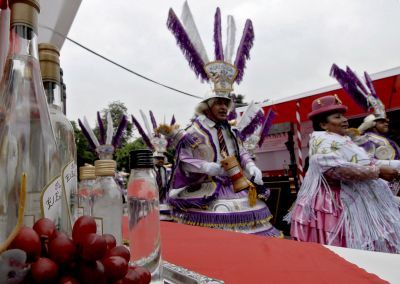Peru toasts pisco boom in annual cocktail day

Peruvians have been lifting their glasses in a toast to Pisco Sour, an emblematic national cocktail which has enjoyed a tremendous boom over the past decade, as pisco brandy production rose fourfold and exports by a factor of eleven.
"Pisco is part of our identity, it has been made in Peru for over 400 years, and Pisco Sour, the cocktail made from pisco, is a now a national symbol," Jose Luis Chicoma Lucar, deputy minister of Industry, told AFP on the eve of the annual "Pisco Sour Day" on February 6.
Since 2003, Peru has dedicated the first weekend in February to pisco-tasting parties across the country, with a giant pisco fountain erected in Lima's main square for the occasion.
The frothy, tangy cocktail was invented in a hotel bar at the start of the last century by an American named Morris, as an adaptation of the classic Whisky Sour.
Its fame grew during the oil bonanza of the 1940s and 50s, thanks to glamorous Hollywood stars such as Orson Welles, Ava Gardner and John Wayne, who sipped Pisco Sours in the now notorious Hotel Bolivar in Lima's historic center.
Once a jealously guarded secret, Morris's original recipe is now well known, said Eloy Cuadros, who has been bartending for over 40 years at the drink's birthplace, the Hotel Maury.
"Three (measures) of pisco, one of lemon, one of sugar syrup, one egg white, ice, and the final touch: a drop of Angostura bitter," he said.
Today, interest for the Peruvian tipple, especially from North Americans, is booming again.
"Pisco has already been proclaimed part of Peru's cultural heritage. The next step is to get Peru's pisco and gastronomy recognized internationally, and put it on UNESCO's Intangible Cultural Heritage list," Chicoma told AFP.
Peruvian exports of pisco overtook Chile's in 2009, he added proudly.
Pisco is one of many diplomatic thorns between Latin American neighbors Peru and Chile - both countries claim the spirit as their own, and are battling for its exclusive designation of origin.
"Pisco is an actual place which belongs to Peruvian history," said Peruvian historian and pisco defender Lorenzo Huertas. The member of the Peruvian Academy of Pisco insisted that designations of origin are linked to geography.
"Pisco means bird (in the Quechua Native American language), after the birds which inhabited the Pisco valley" some 250 kilometers (150 miles) south of Lima, Huertas said.
Peru lost its monopoly on pisco to countries like Chile and Argentina around the mid-18th century, as Peruvian farmers turned to more lucrative businesses like sugar and cotton.
Gaston Acurio, a Peruvian chef and popular icon for his role in promoting the country's gastronomy, is one of many who believe the country's pisco is now undergoing a "revolution", along with its cuisine.
"A decade ago, for every 10 whiskies served, only one Pisco Sour was prepared. Now the tables have been turned," Acurio said.
But the pisco path to success is not open to everyone as many producers lack financial backing and professional training to expand their businesses.
Most of the 300 pisco producers along the southern coast are small businesses, according to deputy minister Chicoma.
With difficult times ahead after devastating rains in Peru's main tourism destinations of Cusco and Machu Picchu, the Andean nation has to diversify its economy further, Jose Marsano, an economist at the Peruvian Tourism Observatory, told AFP.
One way would be to promote Pisco Sour as a key element of its "Brand Peru" strategy, Marsano said.
Subscribe to Independent Premium to bookmark this article
Want to bookmark your favourite articles and stories to read or reference later? Start your Independent Premium subscription today.

Join our commenting forum
Join thought-provoking conversations, follow other Independent readers and see their replies